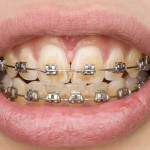
Orthodontic treatment is usually carried out in the early teenage years and there is a continuing high level of demand for treatment. Most orthodontic treatment is carried out using fixed appliances and this depends on the success of the bond between the tooth and the metal bracket. A range of different adhesive agents (composites, glass ionomer, resin-modified glass ionomers, compomers) are available which can be either set by a chemically reaction chemical curing) or using a light (light curing).
The aim of this Cochrane review was to evaluate different orthodontic adhesives for bonding.
Methods
Searches were conducted in the Cochrane Oral Health’s Trials Register, the Cochrane Central Register of Controlled Trials (CENTRAL) Medline, Embase,), the US National Institutes of Health Ongoing Trials Register (ClinicalTrials.gov) and the World Health Organization International Clinical Trials Registry Platform with no restrictions on language or date.
Randomised controlled trials (RCTs) and controlled clinical trials (CCTs) comparing two different adhesive groups for attaching fixed orthodontic appliances were considered. The primary outcome was adhesive failure with decalcification as a secondary outcome. A narrative synthesis was presented.
Results
Three trials satisfied the inclusion criteria. A chemical cured composite was compared with a light cured composite (one trial), a conventional glass ionomer cement (one trial) and a polyacid-modified resin composite (compomer) (one trial). The quality of the trial reports was generally poor.
Conclusions
The authors concluded: –
There is no clear evidence on which to make a clinical decision of the type of orthodontic adhesive to use.
Comments
This Cochrane review is an update of an earlier version on this question published in 2003. Despite the increasing demand for orthodontic treatment it is perhaps a little disappointing that no new trials have been published since 2003 that meet the inclusion criteria for this review. As the authors point out in the discussion there have been many studies of orthodontic adhesives, mainly comparing chemical cured (CC) composite with either light cured (LC) composite or conventional chemical cured glass ionomer cement (CC GIC) but few that have been subject to appropriate statistical analysis.
The authors list 9 points for researchers to consider when researching this question in the future, which sadly are the same as those noted in 2003.
These are:-
- Undertaking randomised controlled trials involving resin- modified light cured glass ionomer cement (LC GIC) or compomers.
- Calculating a sample size a priori.
• Stating clear inclusion and exclusion criteria. - Describing patient withdrawal and drop outs and modifying the statistical analysis if appropriate.
- Assessing for occlusal interferences that may affect bond failure.
- Attempting to make studies single blind (patient) or double blind (patient and operator) if feasible.
- Treating all patients in the same way apart from the intervention.
- Measuring decalcification as a secondary outcome where appropriate.
- Using appropriate statistical analysis and involving a statistician in the design and analysis of the trial. In split-mouth studies, it is important that the data are analysed taking the clustering or pairing within the patient into account.
Links
Primary Paper
Mandall NA, Hickman J, Macfarlane TV, Mattick RC, Millett DT, Worthington HV. Adhesives for fixed orthodontic brackets. Cochrane Database Syst Rev. 2018 Apr 9;4:CD002282. doi: 10.1002/14651858.CD002282.pub2. Review. PubMed PMID: 29630138.

[…] Adhesives for fixed orthodontic brackets […]